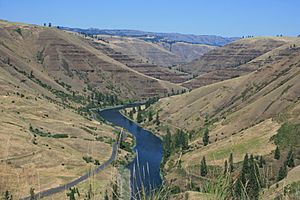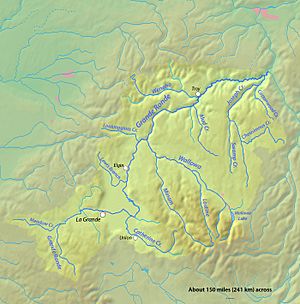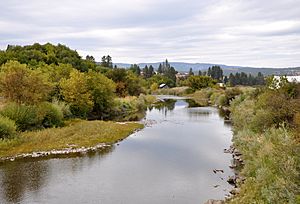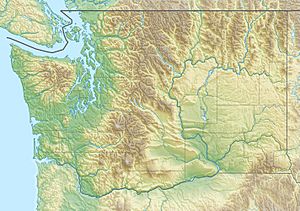Grande Ronde River facts for kids
Quick facts for kids Grande Ronde River |
|
|---|---|

The lower Grande Ronde in Oregon
|
|

Map of the Grande Ronde watershed
|
|
|
Mouth of the Grande Ronde River in Washington
|
|
| Country | United States |
| State | Oregon, Washington |
| Counties | Union and Wallowa counties in Oregon, Asotin County in Washington |
| Cities | La Grande, Elgin |
| Physical characteristics | |
| Main source | Blue Mountains Elkhorn Range 7,444 ft (2,269 m) 44°57′34″N 118°15′38″W / 44.95944°N 118.26056°W |
| River mouth | Snake River 830 ft (250 m) 46°4′49″N 116°58′47″W / 46.08028°N 116.97972°W |
| Length | 182 mi (293 km) |
| Basin features | |
| Basin size | 4,130 sq mi (10,700 km2) |
| Tributaries |
|
| Type: | Wild, Recreational |
| Designated: | October 28, 1988 |
- For other places with the same name, see Grande Ronde (disambiguation).
The Grande Ronde River is a long river, about 182 miles (293 km) long. It flows through northeastern Oregon and southeastern Washington in the United States. This river is a branch of the Snake River. It starts near the Blue Mountains and flows past the Wallowa Mountains. The river goes through a farming area called the Grande Ronde Valley. It also carves out beautiful canyons as it travels.
River's Journey
The Grande Ronde River begins in the Blue Mountains. This area is close to the Anthony Lakes recreation spot. It is located in the Wallowa–Whitman National Forest in southwestern Union County. This starting point is about 20 miles (32 km) south of La Grande.
The river first flows north along the east side of the Blue Mountains. Then it turns east, passing by La Grande. After that, it generally heads northeast through the Grande Ronde Valley. Here, the river takes many turns, winding between the Blue Mountains and the Wallowa Mountains. East of La Grande, it meets Catherine Creek.
About 10 miles (16 km) northwest of Minam, the Grande Ronde River is joined by the Wallowa River from the southeast. It then meets the Wenaha River at Troy, just south of the Washington border. The river then crosses into southeastern Washington. It flows through the very corner of the state before joining the Snake River at Rogersburg, Washington. This spot is about 5 miles (8 km) north of the Oregon border. It is also about 15 miles (24 km) downstream from where the Salmon River joins the Snake. About 2 miles (3 km) before it reaches the Snake River, the Grande Ronde receives Joseph Creek from the south.
The Grande Ronde River meets the Snake River at a point called river mile 169. This means it is 169 miles (272 km) from the mouth of the Snake River. This spot is also 493 miles (793 km) from where the Columbia River flows into the ocean.
River Changes
East of La Grande, in the Grande Ronde Valley, there is a special channel. This channel is about 5 miles (8 km) long. It helps the river avoid a long, winding loop. This change allows people to easily use the river's water for irrigation, which means watering crops.
River's Past

In the early 1800s, many Native American tribes lived in the river's valley. These included the Nez Perce, Umatilla, Walla Walla, and Cayuse tribes. Today, many old archaeological sites can be found around the river. These sites show how people lived there long ago.
The name "Grande Ronde River" was given to it before 1821. It was named by French Canadian explorers and traders called voyageurs. "Grande Ronde" is a French name that means "great round."
A part of the Grande Ronde River and its valley was once part of the Oregon Trail. This famous trail was used by settlers moving west. The first settlers used this part of the trail in 1844. A person named Moses "Black" Harris led his group to the river. Then they turned northwest to cross the Blue Mountains. This path became a regular part of the Oregon Trail for many travelers. Some English-speaking travelers called it the "Grand Round River."
In 1988, the United States Congress made a special rule for about 44 miles (71 km) of the river. This part, from where it meets the Wallowa River to the Oregon–Washington border, was named the Grande Ronde Wild and Scenic River. This means it is protected as part of the National Wild and Scenic Rivers System.
Today, the river is a popular place for outdoor activities. Many people come here for hunting, especially for animals like mule deer, elk, black bear, cougar, and bighorn sheep. Fishing, rafting, and hiking are also popular along the protected Wild and Scenic part of the river. Most of the middle parts of the river cannot be reached by cars or other motor vehicles.
Fish and Wildlife
The Grande Ronde River is home to many types of fish. These include spring chinook salmon, summer steelhead, and bull trout. You can also find mountain whitefish and other fish species here. The river is a good place for people to fish for steelhead. Some Native American tribes also fish for spring chinook salmon here.


